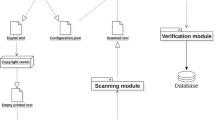Abstract
Although technology for automatic grading of multiple choice exams has existed for several decades, it is not yet as widely available or affordable as it should be. The main reasons preventing this adoption are the cost and the complexity of the setup procedures. In this paper, Eyegrade, a system for automatic grading of multiple choice exams is presented. While most current solutions are based on expensive scanners, Eyegrade offers a truly low-cost solution requiring only a regular off-the-shelf webcam. Additionally, Eyegrade performs both mark recognition as well as optical character recognition of handwritten student identification numbers, which avoids the use of bubbles in the answer sheet. When compared with similar webcam-based systems, the user interface in Eyegrade has been designed to provide a more efficient and error-free data collection procedure. The tool has been validated with a set of experiments that show the ease of use (both setup and operation), the reduction in grading time, and an increase in the reliability of the results when compared with conventional, more expensive systems.








Similar content being viewed by others
Notes
http://www.gravic.com/remark/officeomr/ (accessed 10-1-2011).
Available at http://www.it.uc3m.es/jaf/eyegrade.
http://www.gradecam.com (accessed 10-1-2011).
http://www.python.org/ (accessed 10-1-2011).
http://opencv.willowgarage.com/ (accessed 10-1-2011).
http://laurikari.net/tre/ (accessed 10-1-2011).
http://www.pygame.org/ (accessed 10-1-2011).
References
Apampa K, Wills G, Argles D (2009) Towards security goals in summative e-assessment security. In: International conference for internet technology and secured transactions
Deng H, Wang F, Liang B (2008) A low-cost OMR solution for educational applications. In: IEEE international symposium on parallel and distributed processing with applications. IEEE Press, New York, pp 967–970
Duda RO, Hart PE (1972) Use of the hough transformation to detect lines and curves in pictures. Commun ACM 15(1):11–15
Forsythe G, Wirth N (1965) Automatic grading programs. Commun ACM 8:275–278
Karavirta V, Korhonen A, Malmi L (2006) On the use of resubmissions in automatic assessment systems. Comput Sci Educ 16(3):229–240
Kubo H, Ohashi H, Tamamura M, Kowata T, Kaneko I (2004) Shared questionnaire system for school community management. In: International symposium on applications and the internet, IEEE, pp 408–414
Norris J, Pauli R, Bray D (2007) Mood change and computer anxiety: a comparison between computerised and paper measures of negative affect. Comput Hum Behav 23(6):2875–2887
Rane A, Kumar A, Saini H, Sasikumar M (2009) Extending moodle to support offline assessments. In: Proceedings of national seminar on e-learning and e-learning technologies (ELELTECH), pp 31–39
Saengtongsrikamon C, Meesad P, Sodsee S (2009) Scanner-based optical mark recognition. J Inf Technol (Thailand) 9:69–73
Twigg C (2003) Improving learning and reducing costs. URL http://www.thencat.org/PCR/Rd1Lessons.pdf
Verdú E, Regueras LM, Verdú MJ, De Castro JP, Pérez MA (2008) An analysis of the research on adaptive learning: the next generation of e-learning. WSEAS Trans Inf Sci Appl 5(6):859–868
Winters T, Payne T (2005) What do students know?: an outcomes-based assessment system. In: Proceedings of the first international workshop on computing education research. ACM, New York, USA, ICER ’05, pp 165–172
Zammit A (2009) quexf an open source, web based paper form verification and data entry system. http://quexf.sourceforge.net/
Acknowledgments
This work was partially funded by the EEE project, “Plan Nacional de I+D+I TIN2011-28308-C03-01” and the “Emadrid: Investigación y desarrollo de tecnologias para el e-learning en la Comunidad de Madrid” project (S2009/TIC-1650).
Author information
Authors and Affiliations
Corresponding author
Electronic supplementary material
Below is the link to the electronic supplementary material.
Rights and permissions
About this article
Cite this article
Fisteus, J.A., Pardo, A. & García, N.F. Grading Multiple Choice Exams with Low-Cost and Portable Computer-Vision Techniques. J Sci Educ Technol 22, 560–571 (2013). https://doi.org/10.1007/s10956-012-9414-8
Published:
Issue Date:
DOI: https://doi.org/10.1007/s10956-012-9414-8




